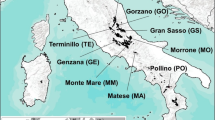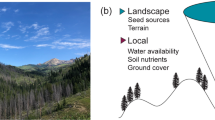Abstract
We studied the effects of logging history, topography, and potential insolation on the lower-elevation limit of existing spruce-fir forest in Great Smoky Mountains National Park (GRSM). Dummy-variable regression, analysis of variance, and classification trees were applied to environmental data within a geographic information system framework. The effect of logging history on the lower limit of spruce-fir depended on aspect. On north-facing slopes (270°– 90°), the presence of spruce-fir was independent of both logging history and potential insolation. On south-facing sites (90°–270°), the elevation of spruce-fir was significantly higher (by 122 m) in areas that had been logged historically. Classification-tree models suggested an even greater logging effect, indicating that both the lower limit and the upper dominance zone of spruce-fir forest are, on average, nearly 200 m higher in historically logged landscapes. Presence of spruce-fir on south aspects was also significantly related to potential insolation, but the strength of this effect was not dependent on logging history. Classification-tree models, developed separately using data from logged sites versus unlogged sites, were used to estimate the current area of spruce-fir forest in the park expected under the hypothetical scenario that no spruce-fir had been logged (38,675 ha) versus the alternate scenario that it had hall been logged (11,727 ha). At present the area of spruce-fir forest in the park is 21,242 ha. We found greater prevalence of spruce-fir on the Tennessee side of the divide on south aspects and historically logged sites, possibly due to greater occurrence of westerly winds and associated cloud cover.
Similar content being viewed by others
References
Bertness MD, Callaway R (1994) Positive interactions in communities. Trends Ecol Evol 9:191–193
Busing RT, Pauley EF (1994) Mortality trends in a southern Appalachian red spruce population. Forest Ecol Manage 64: 41–45
Cogbill CV, White PS (1991) The latitude-elevation relationship for spruce-fir forest and treeline along the Appalachian mountain chain. Vegetatio 94:153–175
De’Ath G (2002) Multivariate regression trees: a new technique for modeling species-environment relationships. Ecology 83:1105–1117
Delcourt HR, Delcourt PA (1984) Late-quaternary history of the spruce-fir ecosystem in the southern Appalachian mountain region. In: White PS (ed) The Southern Appalachian Spruce-Fir Ecosystem: Its Biology and Its Threats. U.S. Department of Interior, National Park Service, Research/Resource Management, Rep. SER-71, pp22–35
Dickson RR (1959) Some climate-altitude relationships in the Southern Appalachian Mountain region. Am Meteorol Soc Bull 40:352–359
Dull CW, Ward JD, Brown HD, Ryan GW, Clerke WH, Uhler RJ (1988) Evaluation of spruce and fir mortality in the Southern Appalachian mountains. Rep. R8–PR 13. Atlanta: U.S. Department of Agriculture, Forest Service, Southern Region, State and Private Forestry, Forest Pest Management. p 92
Hacker SD, Gaines SD (1997) Some implications of direct positive interactions for community species diversity. Ecology 78:1990–2003
Korstian CF (1937) Perpetuation of spruce on cut-over and burned lands in the higher southern Appalachian mountains. Ecol Monogr 7:125–167
Kumar L, Skidmore AK, Knowles E (1997) Modelling topographic variation in solar radiation in a GIS environment. Int J Geogr Inform Sci 11:475–497
Noss RF, LaRoe ET, Scott JM (1995) Endangered ecosystems of the United States: A preliminary assessment of loss and degradation. U.S. Dept. of the Interior, National Biological Service, Washington, D.C
Petraitis PS, Latham RE (1999) The importance of scale in testing the origins of alternative community states. Ecology 80: 429–442
Pyle C (1984) Pre-park disturbance in the spruce-fir forests of Great Smoky Mountains National Park. In: White PS (ed) The Southern Appalachian Spruce-Fir Ecosystem: Its Biology and Its Threats. U.S. Department of Interior, National Park Service, Research/Resource Management, Rep. SER-71, pp115–130
Pyle C, Schafale MP (1988) Land use history of three spruce-fir forest sites in southern Appalachia. J Forest History,32:4–21
SAMAB (Southern Appalachian Man and Biosphere) 1996 – http://www.samab.org/data/data.html. “Southern Appalachian Assessment Land Cover Mapping Project Final Report.” Distribution information, Metadata information: Karl A. Hermann, National Biological Service Cooperative, University of Tennessee, 17 Ridgeway Road, Norris, TN 37828
Schofield WB (1960) The ecotone between spruce-fir and deciduous forest in the Great Smoky Mountains. Ph.D. Dissertation, Duke University, Durham, NC
Shanks RE (1954) Climates of the Great Smoky Mountains. Ecology 35:354–361
Siccama TG (1974) Vegetation, soil, and climate on the Green Mountains of Vermont. Ecol Monogr 44: 325–349
Smith GF, Nicholas NS (1998) Patterns of overstory composition in the fir and fir-spruce forests of the Great Smoky Mountains after balsam woolly adelgid infestation. Am Midland Nat 139:340–352
Sullivan J (1993) Abies fraseri, Picea rubens. U.S. Department of Agriculture, Forest Service, Rocky Mountain Research Station, Fire Sciences Laboratory (2002, April). Fire Effects Information System, [Online: http://www.fs.fed.us/database/feis/plants/tree/picrub/introductory.html, http://www.fs.fed.us/database/feis/plants/tree/abifra/introductory.html]
Tewksbury JJ, Lloyd JD (2001) Positive interactions under nurse-plants: Spatial scale, stress gradients, and benefactor size. Oecologia 127: 425–434
White PS, Buckner ER, Pittillo JD, Cogbill CV (1993) High-elevation forests: spruce-fir forests, northern hardwood forests, and associated communities. In Biodiversity of the Southeastern United States: Upland Terrestrial Communities, pp 305–338
White PS, MacKenzie MD, Busing RT (1985) Natural disturbance and gap phase dynamics in southern Appalachian spruce-fir forests. Can J Forest Res 15:233–240
White PS, Miller RI (1988) Topographic models of vascular plant richness in the Southern Appalachian high peaks. J Ecol 76: 192–199
White PS, Wilds SP, Stratton DA (2001) The distribution of heath balds in the Great Smoky Mountains, North Carolina and Tennessee. J Veg Sci 12: 453–466
Whittaker RH (1956) Vegetation of the Great Smoky Mountains. Ecological Monographs 26: 1–80
Author information
Authors and Affiliations
Corresponding author
Rights and permissions
About this article
Cite this article
Hayes, M., Moody, A., White, P.S. et al. The influence of logging and topography on the distribution of spruce-fir forests near their Southern limits in Great Smoky Mountains National Park, USA. Plant Ecol 189, 59–70 (2007). https://doi.org/10.1007/s11258-006-9166-8
Received:
Accepted:
Published:
Issue Date:
DOI: https://doi.org/10.1007/s11258-006-9166-8




